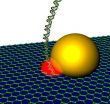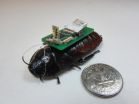Golden approach to high-speed DNA reading
Berkeley researchers create unique graphene nanopores with optical antennas for DNA sequencing
2014-11-06
(Press-News.org) High-speed reading of the genetic code should get a boost with the creation of the world's first graphene nanopores - pores measuring approximately 2 nanometers in diameter - that feature a "built-in" optical antenna. Researchers with Berkeley Lab and the University of California (UC) Berkeley have invented a simple, one-step process for producing these nanopores in a graphene membrane using the photothermal properties of gold nanorods.
"With our integrated graphene nanopore with plasmonic optical antenna, we can obtain direct optical DNA sequence detection," says Luke Lee, the Arnold and Barbara Silverman Distinguished Professor at UC Berkeley.
Lee and Alex Zettl, a physicist who holds joint appointments with Berkeley Lab's Materials Sciences Division and UC Berkeley's Physics Department, were the leaders of a study in which a hot spot on a graphene membrane formed a nanopore with a self-integrated optical antenna. The hot spot was created by photon-to-heat conversion of a gold nanorod.
"We believe our approach opens new avenues for simultaneous electrical and optical nanopore DNA sequencing and for regulating DNA translocation," says Zettl, who is also a member of the Kavli Energy Nanoscience Institute (Kavli ENSI).
Nanopore sequencing of DNA, in which DNA strands are threaded through nanoscale pores and read one letter at a time, has been touted for its ability to make DNA sequencing a faster and more routine procedure. Under today's technology, the DNA letters are "read" by an electrical current passing through nanopores fabricated on a silicon chip. Trying to read electrical signals from DNA passing through thousands of nanopores at once, however, can result in major bottlenecks. Adding an optical component to this readout would help eliminate such bottlenecks.
"We obtain direct and enhanced optical signals at the junction of a nanopore and its optical antenna," Lee says. "Simultaneously correlating this optical signal with the electrical signal from conventional nanopore sequencing provides an added dimension that would be an enormous advantage for high-throughput DNA readout."
A key to the success of this study was the single-step photothermal mechanism that enabled the creation of graphene nanopores with self-aligned plasmonic optical antennas. The dimensions of the nanopores and the optical characteristics of the plasmonic antennas are tunable, with the antenna functioning as both optical signal transducer and enhancer. The atomically thin nature of the graphene membrane makes it ideal for high resolution, high throughput, single-molecule DNA sequencing. DNA molecules can be labeled with fluorescent dyes so that each base-pair fluoresces at a signature intensity as it passes through the junction of the nanopore and its optical antenna.
"In addition, either the gold nanoplasmonic optical antenna or the graphene can be functionalized to be responsive to different base-pair combinations," Lee says. "The gold plasmonic optical antenna can also be functionalized to enable the direct optical detection of RNA, proteins, protein-protein interactions, DNA-protein interactions, and other biological systems."
INFORMATION:
The results of this study were reported in Nano Letters in a paper titled "Graphene Nanopore with a Self-Integrated Optical Antenna." Lee is the corresponding author. Other co-authors in addition to Zettl were SungWoo Nam, Inhee Choi, Chi-cheng Fu, Kwanpyo Kim, SoonGweon Hong and Yeonho Choi.
This research was primarily supported by the DOE Office of Science.
Lawrence Berkeley National Laboratory addresses the world's most urgent scientific challenges by advancing sustainable energy, protecting human health, creating new materials, and revealing the origin and fate of the universe. Founded in 1931, Berkeley Lab's scientific expertise has been recognized with 13 Nobel prizes. The University of California manages Berkeley Lab for the U.S. Department of Energy's Office of Science. For more, visit http://www.lbl.gov.
DOE's Office of Science is the single largest supporter of basic research in the physical sciences in the United States, and is working to address some of the most pressing challenges of our time. For more information, please visit the Office of Science website at science.energy.gov/.
[Attachments] See images for this press release:


ELSE PRESS RELEASES FROM THIS DATE:
2014-11-06
ATLANTA, GA (November 6, 2014) – Whether allergy sufferers have symptoms that are mild or severe, they really only want one thing: relief. So it's particularly distressing that the very medication they hope will ease symptoms can cause different, sometimes more severe, allergic responses.
According to a presentation at the American College of Allergy, Asthma and Immunology (ACAAI) Annual Scientific Meeting, an allergic response to a medication for allergies can often go undiagnosed. The presentation sheds light on adverse responses to topical skin preparations; ...
2014-11-06
Berlin, Germany (November, 2014) – A specimen of the ancient horse Eurohippus messelensis has been discovered in Germany that preserves a fetus as well as parts of the uterus and associated tissues. It demonstrates that reproduction in early horses was very similar to that of modern horses, despite great differences in size and structure. Eurohippus messelensis had four toes on each forefoot and three toes on each the hind foot, and it was about the size of a modern fox terrier. The new find was unveiled at the 2014 Annual Meeting of the Society of Vertebrate Paleontology ...
2014-11-06
VIDEO:
Scientists at the SUNY College of Environmental Science and Forestry (ESF) are growing the first American chestnut trees that can withstand the blight that virtually eliminated the once-dominant tree from...
Click here for more information.
SYRACUSE, N.Y. — Scientists at the SUNY College of Environmental Science and Forestry (ESF) are growing the first American chestnut trees that can withstand the blight that virtually eliminated the once-dominant tree from the eastern ...
2014-11-06
WASHINGTON, DC, November 6, 2014 -- Go to almost any American high school and the elements of teen social networks become quickly apparent: the cliques, the pecking orders, and the varying degrees of self-segregation by race, age, gender, and social status.
For years, sociologists have identified seemingly universal human instincts that spur this kind of sorting. These include the desires for familiarity and certainty; for control and dominance; and for security and support.
But as ubiquitous as those instincts are, students in some schools form more cliquish, hierarchical, ...
2014-11-06
North Carolina State University researchers have developed technology that allows cyborg cockroaches, or biobots, to pick up sounds with small microphones and seek out the source of the sound. The technology is designed to help emergency personnel find and rescue survivors in the aftermath of a disaster.
The researchers have also developed technology that can be used as an "invisible fence" to keep the biobots in the disaster area.
"In a collapsed building, sound is the best way to find survivors," says Dr. Alper Bozkurt, an assistant professor of electrical and computer ...
2014-11-06
Berlin, Germany (November, 2014) – A new study, which teamed cutting-edge engineering techniques with paleontology, has found that take-off capacity may have determined body size limits in extinct flying reptiles. The research simulated pterodactyl flight using computer modeling, and will be presented at the upcoming Society of Vertebrate Paleontology meeting in Berlin. Findings suggest that a pterodactyl with a wingspan of 12m or more would simply not be able to get off the ground.
Pterosaurs (commonly known as pterodactyls) were truly giants of the sky. With ...
2014-11-06
For ALMA's first observations in its new and most powerful mode, researchers pointed the antennas at HL Tauri — a young star, about 450 light-years away, which is surrounded by a dusty disc [1]. The resulting image exceeds all expectations and reveals unexpectedly fine detail in the disc of material left over from star birth. It shows a series of concentric bright rings, separated by gaps [2].
"These features are almost certainly the result of young planet-like bodies that are being formed in the disc. This is surprising since such young stars are not expected to ...
2014-11-06
Astronomers have captured the best image ever of planet formation around an infant star as part of the testing and verification process for the Atacama Large Millimeter/submillimeter Array's (ALMA) new high-resolution capabilities.
This revolutionary new image reveals in astonishing detail the planet-forming disk surrounding HL Tau, a Sun-like star located approximately 450 light-years from Earth in the constellation Taurus.
ALMA uncovered never-before-seen features in this system, including multiple concentric rings separated by clearly defined gaps. These structures ...
2014-11-06
Tiny extensions on cells, cilia, play an important role in insulin release, according to a new study, which is published in Nature Communications. The researchers report that the cilia of beta cells in the pancreas are covered with insulin receptors and that changed ciliary function can be associated with the development of type 2 diabetes.
Cilia are tiny extensions on cells and they are credited with many important functions, including transduction of signals in cells. Defects in cilia have been implied in several diseases and pathological conditions. Thus, scientists ...
2014-11-06
VIDEO:
A 10-day-old zebrafish gets its stripes over the next 30 days, one image taken a day.
Click here for more information.
Within weeks of publishing surprising new insights about how zebrafish get their stripes, the same University of Washington group is now able to explain how to "erase" them.
The findings – the first published Aug. 28 in Science and the latest in the Nov. 6 issue of Nature Communications – give new understanding about genes and cell behaviors ...
LAST 30 PRESS RELEASES:
[Press-News.org] Golden approach to high-speed DNA reading
Berkeley researchers create unique graphene nanopores with optical antennas for DNA sequencing







